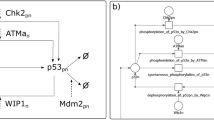Abstract
Living organisms, as well as their functional blocks, are complex systems. From this follows that for their deep understanding it is necessary to use systems methods for their analysis. The basis for such an analysis is a precise mathematical model. It seems that models expressed as Petri nets are especially promising in the area of modeling and analysis of biological systems. In this paper a Petri net based approach for such an analysis is presented on the example of a complex process of atherosclerosis development. Classic methods of analysis based on MCT sets and t-clusters were used. Additionally, extended methods of analysis such as significance analysis and knockout analysis were applied. Significance analysis can be used to determine which elementary subprocesses are key to the functioning of the modeled system, while knockout analysis can be used to confirm the results of the significance analysis.
Access this chapter
Tax calculation will be finalised at checkout
Purchases are for personal use only
Similar content being viewed by others
References
Chmielewska, K., Formanowicz, D., Formanowicz, P.: The effect of cigarette smoking on endothelial damage and atherosclerosis development - modeled and analyzed using Petri nets. Arch. Control Sci. 27(2), 211–228 (2017)
Formanowicz, D., Gutowska, K., Formanowicz, P.: Theoretical studies on the engagement of interleukin 18 in the immuno-inflammatory processes underlying atherosclerosis. Int. J. Mol. Sci. 19(11), 3476 (2018)
Gutowski, Ł., Gutowska, K., Pioruńska-Stolzmann, M., Formanowicz, P., Formanowicz, D.: Systems approach to study associations between OxLDL and abdominal aortic aneurysms. Int. J. Mol. Sci. 20(16), 3909 (2019)
Murata, T.: Petri nets: properties, analysis and applications. Proc. IEEE 77(4), 541–580 (1989)
Reising, W.: Understanding Petri Nets. Modeling Techniques, Analysis Methods, Case Studies. Springer, Heidelberg (2013)
David, R., Alla, H.: Discrete, Continuous, and Hybrid Petri Nets. Springer, Heidelberg (2005)
Grafahrend-Belau, E., Schreiber, F., Heiner, M., Sackmann, A., Junker, B.H., et al.: Modularization of biochemical networks based on classification of Petri net t-invariants. BMC Bioinform. 9(1), 90 (2008)
Koch, I., Reisig, W., Schreiber, F. (eds.): Modeling in Systems Biology. The Petri Net Approach. Springer, Heidelberg (2010)
Formanowicz, D., Kozak, A., Głowacki, T., Radom, M., Formanowicz, P.: Hemojuvelin - hepcidin axis modeled and analyzed using Petri nets. J. Biomed. Inform. 46(6), 1030–1043 (2013)
Sackmann, A., Heiner, M., Koch, I.: Application of Petri net based analysis techniques to signal transduction pathways. BMC Bioinform. 7(1), 482 (2006)
Heiner, M., Herajy, M., Liu, F., Rohr, C., Schwarick, M.: Snoopy - a unifying Petri net tool. In: International Conference on Application and Theory of Petri Nets and Concurrency, pp. 398–407. Springer, Heidelberg (2012)
Kaufman, L., Rousseeuw, P.J.: Finding Groups in Data: An Introduction to Cluster Analysis, vol. 344. Wiley, New York (1990)
Calinski, T., Harabasz, J.: A dendrite method for cluster analysis. Commun. Stat. 3(1), 1–27 (1974)
Acknowledgement
This research has been partially supported by the National Science Centre (Poland) grant No. 2012/07/B/ST6/01537 and by the statutory funds of Poznan University of Technology.
Author information
Authors and Affiliations
Corresponding author
Editor information
Editors and Affiliations
Rights and permissions
Copyright information
© 2020 Springer Nature Switzerland AG
About this paper
Cite this paper
Gutowska, K., Formanowicz, D., Formanowicz, P. (2020). Systems Approach Based on Petri Nets as a Method for Modeling and Analysis of Complex Biological Systems Presented on the Example of Atherosclerosis Development Process. In: Bartoszewicz, A., Kabziński, J., Kacprzyk, J. (eds) Advanced, Contemporary Control. Advances in Intelligent Systems and Computing, vol 1196. Springer, Cham. https://doi.org/10.1007/978-3-030-50936-1_49
Download citation
DOI: https://doi.org/10.1007/978-3-030-50936-1_49
Published:
Publisher Name: Springer, Cham
Print ISBN: 978-3-030-50935-4
Online ISBN: 978-3-030-50936-1
eBook Packages: Intelligent Technologies and RoboticsIntelligent Technologies and Robotics (R0)




